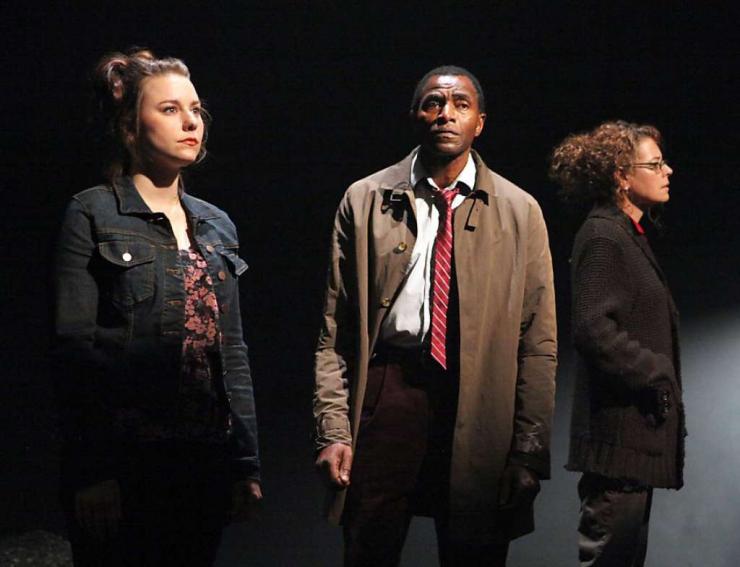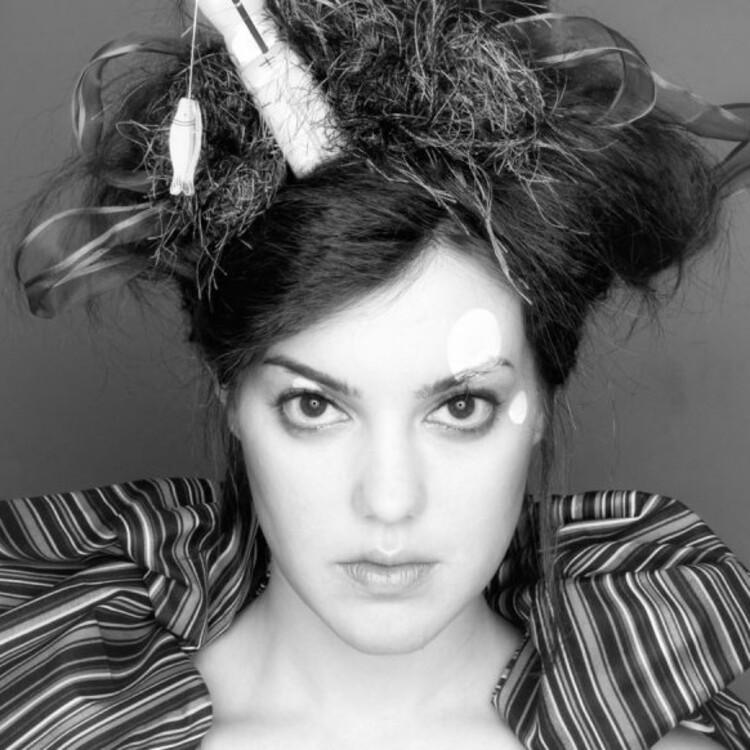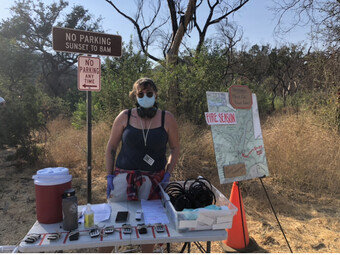A Drama of Two Cities
Dublin and San Francisco
One of the most prominent symbols in Mark O’Rowe’s Terminus, now in its first American production at San Francisco’s Magic Theatre under the direction of Jon Tracy, is the crane. Two of the show’s three characters—whom O’Rowe calls only A, B, and C—tell of summiting the formidable machine. For B (Marissa Keltie), a young woman, it’s after a night at the pub, when she heads to a construction site with her companions: “hey, presto!—we’re out on the arm, defying harm, perching precarious, unprotected, this vantage point that he’s selected, revealing, in a sense, the city’s sullied magnificence.” For C (Carl Lumbly), a man closer to middle age, it’s after a murderous rampage, a surreal chase sequence, and an airborne battle with his own soul: “my soul and I continue up and at a certain height, descend toward a construction site and enter, alight on a crane in its centre, the arm, upon which, without harm, we land.”
O’Rowe’s play, which is set in Dublin, premiered at the Abbey Theatre in 2007, as Ireland, too, was “perching precarious.” The Celtic Tiger era, which began in 1994, was both at its height and near its end in 2007. One of the chief features of this economic boom was a real estate bubble that brought a huge increase in construction, including, most noticeably, many new skyscrapers. If the cranes in Terminus are a symbol of that era, the way O’Rowe uses them stinks with unease, a sense of impending collapse, as both characters who make it to the arm of the crane plummet from it in spectacular ways. B falls off in trying to escape an unwanted sexual advance, but she never touches the earth: a winged creature with “a face composed of worms entire” catches her and flies her away. C, having been “impaled” with the tail of his disembodied soul, says:
He lifts me above his head and, as I scream, arms and legs flaying, he tosses me off the crane and, once I fall to a certain height, the tail, still in my throat, grabs tight and my weight pulls my innards inside out till I’m suspended, swinging about on a length of intestine, a little less than dignified, you’ll agree, looking up to see him grinning widely, having tied my entrails onto the arm of the crane.
Cranes also dot our skyline here in San Francisco right now, and for many residents they are harbingers of a changing city, one that might soon be little more than a bedroom and a playground for Big Tech workers whose money is pricing out everyone else, including the artists and weirdos who help make the city so desirable in the first place. Every week here seems to bring another lament for urban paradise lost, all while city government continues to encourage office towers, condos, and the cranes that build them. While our economic bubble, unlike Ireland’s, doesn’t seem to be in danger of bursting any time soon, we are leery of another kind of collapse: the slow erosion of spirit and culture.
You constantly feel as if you can’t bear to listen to it any more yet never want it to stop. That’s what a voice of a generation can do: make the very act of perception both our richest pleasure and deepest pain.
The cranes in Terminus are products of a world in which evil is banal and ghastly violence is unremarkable. C, upon surveying a bloodbath he’s created from a pub parking lot skirmish—“I make my way back to the scene of the crime. Two fellas there, one dead, one dying, whose head I go flying over as I drive away—a bump, a spray of gore on the door and the head’s a head no more”—has a crippling thought, not of remorse, but of his phobia: “Heading now towards the smoke, the blood on my paws causes me to re-evoke my severe affliction: an overpowering fear of women, all my life, my propensity, when in their company, to flee for fear of getting sick; and at nearly thirty-six years old, my longing to hold or even kiss one.”

Photo by Jennifer Reiley.
Whether characters mete out or suffer violence reflects little on how good or likable they are. The urge to hurt is an external force; it strikes capriciously. Much more important than physical pain is emotional pain: For A (Stacy Ross), a former schoolteacher and a crisis hotline operator, her strongest sense of being alone comes, as with C’s, after she murders:
My soul is suddenly filled with the need to see her face, just once, to embrace, to erase for a moment, all trace of this with a kiss, to say, ‘I miss you,’ even if in vain, to explain, to ascertain the name of the film we watched in bed that time with our wine and our treats, to express regret, to set myself at her feet and accept whatever judgment she sees fit to exact.”
This loneliness is amplified in the characters’ isolation onstage: The script mandates that A, B, and C never interact. The play is structured as three interwoven monologues; characters speak at length before ceding the floor, taking turns at almost regular intervals. The set also reflects this isolation. Designer Robert Brill has created a post-apocalyptic landscape with nary a vertical axis. Chips of rubbery, bluish detritus lump together to create mounds and basins reminiscent of the surface of the moon. It is a timeless, placeless place; characters can’t leave, or at least they don’t give a thought to leaving; they only tell their stories. In this way, Terminus is similar to Samuel Beckett’s short Play, which reveals hell as a place where you’re forced to tell the same sad story over and over.
Yet despite all this, Terminus is not ultimately a pessimistic play. O’Rowe creates grotesque images, but his language is so rhapsodic that it can’t help but celebrate humanity as much as it criticizes. His quasi-Shakespearean, quasi-Seussian rhyme and Ginsberg-ian rhythm make music in unexpected places. Here’s B, on the after-hours crowd: “We go, see the slo-mo ebb and flow of pub-spill; the mill, the babble, the rabble of wobbling waywards, exiled and aimless, unlike us as, purposeful and double-file, like kids on a dare, we head who the fuck knows where?”
His stylized language is never just ornamentation; it is in the service of suspenseful, economic storytelling. In the Magic’s production, director Jon Tracy wisely keeps the focus on the language. During each individual monologue, there are no light or sound cues to help the actor flesh out the world he or she is describing. The performers also stand stock-still much of the time; for one of C’s passages, Lumbly even keeps his hands rooted in his pockets for minutes on end. This production is about the simple power of language and the actor’s voice and face to express it. Tracy’s three phenomenal performers create new environments, other characters with but a twitch of a facial muscle, a deft shift in vocal register. They honor O’Rowe’s commas and line breaks but let the words tumble out, selecting places to pause or climax with a true craftsman’s precision; you can appreciate the sophistication of their artistry at the same time as you are totally spellbound by it.
Terminus is at once humanist and anti-humanist, high and low, beautiful and grisly; it is poetic and profane, surreal yet simple, timely and timeless. You constantly feel as if you can’t bear to listen to it any more yet never want it to stop. That’s what a voice of a generation can do: make the very act of perception both our richest pleasure and deepest pain.







Comments
The article is just the start of the conversation—we want to know what you think about this subject, too! HowlRound is a space for knowledge-sharing, and we welcome spirited, thoughtful, and on-topic dialogue. Find our full comments policy here